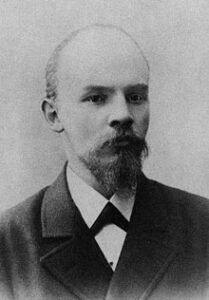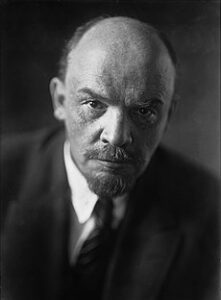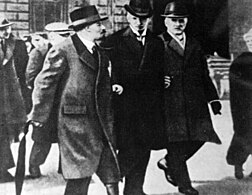One can approach the political activities of Vladimir Ilyich Lenin in different ways, without accepting his ideas at all or completely agreeing with them, but the scale of the personality of the head of the first workers’ and peasants’ state in history is difficult to overestimate, just as it is impossible to deny his enormous influence on the subsequent life of the country.
The childhood and youth of Vladimir Lenin
Every inhabitant of the Soviet Union knows the year and date of birth of Vladimir Ilyich Lenin by memory. He was born on April 10 (22), 1870 in the Volga regional city of Simbirsk, subsequently called Ulyanovsk, from a rather prosperous family. Father Ilya Nikolaevich Ulyanov (1831–1886) served as director of the provincial inspection of public schools. He was the son of a former serf peasant, but by 1877 he managed to advance to the high title of genuine state councilor, 4th class in the table of ranks, which provided the right to nobility not only to him, but also to his descendants born after this date.
Mother Maria Alexandrovna, née Blank (1835–1916), was interested in raising children – in addition to Volodya, there were two additional boys and three girls in the household. Despite the fact that the distance between the eldest sister Anna (1864–1935) and the youngest sister Maria (1878–1937) was 14 years, all the children were quite friendly. Volodya passionately adored his brother Alexander (1866–1887), who was 4 years older than him. Calm and considerate, Alexander always remained a role model for the brothers Volodya and Dmitry (1874–1943). Volodya’s best playmate and playmate was his sister Olga (1871–1891), with whom they were the same age. Subsequently, her early death from typhus stunned the young guy.
From early youth, Volodya Ulyanov grew up as an energetic lad, with a smart and curious mind. At the age of 9 he was assigned to a gymnasium, where he studied extremely well, often getting encouragement. At the beginning of 1886, when Vladimir was 16 years old, the family suddenly lost his father, who died of a cerebral hemorrhage, and soon the Ulyanovs were in for an equally strong shock: in May 1887, the eldest son Alexander and a group of Narodnaya Volya members were executed by court verdict for preparing an assassination attempt. Emperor Alexander III.
Two enormous disasters harmed both the pecuniary well-being of the Ulyanov family and its reputation in regional Simbirsk society. However, in the same 1887, Vladimir graduated from high school with a gold medal for knowledge and exemplary behavior and attended the law department of Kazan University. There is a narrative that it was the death of his older brother that defined the future career of the revolutionary Vladimir Ulyanov (Lenin), a former excellent young man who was not interested in politics.
Career and revolutionary actions of Vladimir Lenin
Immediately after commencing his studies in Kazan, Vladimir Ulyanov joined the People’s Will circle, and three months later he was dismissed from the university without the right to reinstatement for engaging in student disturbances. An aggravating factor was the presence of an executed sibling. Vladimir was listed in the list of untrustworthy individuals, surveillance was formed over him and he was banished to the village of Kokushkino, Kazan province – to an estate that belonged to his aunt on his mother’s side.
Maria Aleksandrovna Ulyanova constantly petitioned for her son to be reinstated in the university, but the authorities were resolute. However, in 1888, Vladimir was permitted to return to Kazan, and in 1890, he was allowed to take tests for a university course as an external student. Persistent independent study helped Vladimir Ulyanov to successfully complete qualification examinations at St. Petersburg University and gain the job of assistant lawyer in Samara, where the Ulyanov family moved in 1889. He began his revolutionary activity early, joining a Marxist group in Kazan in 1888. Here the young revolutionary was significantly impressed by the works of G.V. Plekhanov: after studying them, the opinions of Vladimir Ulyanov began to transition from populist to social democratic.
In 1893, Vladimir Ulyanov went to St. Petersburg, where he continued to work in the legal area. In 1895, on a journey overseas, he directly met the founding leaders of the European social democratic movement: Wilhelm Liebknecht, Paul Lafargue and Grigory Plekhanov. Upon returning to his birthplace, Vladimir Ulyanov made a lot of attempts to reconcile the fragmented St. Petersburg Marxist circles. The consequence of the work done was the “Union of Struggle for the Liberation of the Working Class,” which he chaired. The aim was the downfall of the dictatorship.
At the end of 1895, an arrest followed. After a year in jail in 1897, Vladimir Ulyanov was transported to the settlement of Shushenskoye, Yenisei province. His future wife Nadezhda Krupskaya, whom they met in 1895 at a meeting of a Marxist group, went with him to Siberia for three years. at 1898, under the threat of transporting Nadezhda to St. Petersburg, young people got married at a local country church.
In the same year, another key event had happened for the party career of Vladimir Ulyanov – a congress was convened in Minsk that founded the first Russian Social Democratic Labor Party (RSDLP). Already in exile, Ulyanov decided to create the daily Iskra, which would serve the purpose of unifying Social Democratic groups throughout the Russian Empire.
In exile, Vladimir Ulyanov did not waste time and worked on the book “The Development of Capitalism in Russia,” geared at “legal Marxists” and populists. From Siberia, he managed to make relationships with Marxists in St. Petersburg, Moscow and other places, among whom he earned reputation under the alias K. Tulin.
In the summer of 1900, Vladimir Ulyanov and his wife, near the conclusion of their exile, sailed for Switzerland. Here they published Iskra, whose editorial board also included P.B. Axelrod, Zasulich, G.V. Plekhanov, Yu.O. Martov, A.N. Potresov. Later, the scientific and political journal “Zarya” was established, in the first issue of which an article by Ulyanov “Critics on the Agrarian Question” under the pseudonym N. Lenin – over time, the surname taken from him will supplant the real one, although in total Vladimir Ulyanov used more than 150 pseudonyms. In April 1902, the editorial team of Iskra went to London. Here in the summer of 1903 the Second Congress of the RSDLP was convened, during which the party divided into Bolsheviks and Mensheviks. Vladimir Ulyanov (Lenin) took an active part in the activity of the conference.
In November 1905, Lenin illegally returned to St. Petersburg, where he commanded the preparations for an armed revolt, but in May 1906 he was compelled to depart for Finland and eventually escape to Sweden. Lenin spent the next 10 years in exile, residing in Switzerland, France, and Poland. In 1911, in the Parisian district of Longjumeau, Lenin built a party school where he taught. With the onset of the First World War he resided in Galicia, then moved to Zurich.
Lenin did not foresee the bourgeois revolution of 1917 and did not expect to survive to witness it. In April 1917, the German authorities authorized Lenin to fly to Russia. Upon arriving, Lenin addressed at a gathering with the radical 10 “April Theses,” which was a statement plan for the seizure of power established by the Bolshevik Party. In July 1917, the Provisional Government demanded Lenin’s arrest, and he escaped to Finland. During this era he authored his most major work, State and Revolution.
Participation of Lenin in the October Revolution
In April 1917, Lenin landed in Russia and quickly went underground, and in October of the same year he returned to Petrograd. On the evening of October 24, donning makeup, he made his way to the Smolny Institute, where the headquarters of the rebellion was housed, and assumed direct leadership.
On October 25, Lenin published an appeal regarding his overthrow of the Provisional Government; on the same day, at the Second All-Russian Congress of Soviets, ordinances on land and peace were enacted. On the night of October 26, the Provisional governing was imprisoned at the Winter Palace, and in its stead a new governing body was founded led by Lenin – the Council of People’s Commissars (SNK).
Reforms and internal policy Lenin
In January 1918, Lenin signed a proclamation on the foundation of the Red Army, as well as the basis of the first constitution of the new state – the “Declaration of the Rights of the Working and Exploited People.” He felt it important for Soviet Russia to disengage into the First World War. Despite the resistance of L.D. Trotsky and the allies who joined him in an urgent endeavor to build a universal revolution, the Brest-Litovsk Peace Treaty was reached in March. In the spring of 1918, fearing the conquest of Petrograd by the Germans, Lenin transferred the Soviet administration to Moscow.
In January 1919, a decree “On the separation of church and state” was published; in March of the same year, on the initiative of Lenin, the Communist International was founded, uniting parties of a similar sort from all over the world. When the policies of war communism and surplus appropriation did not explain themselves, excess appropriation was replaced by a tax in kind, and war communism by a new economic policy (NEP). The economy of the nascent country began to revive, and owing to the monetary reform carried out in 1922–1924, the ruble became a freely convertible currency.
Lenin persistently advocated on the growth of state-type businesses, as well as broad electrification. An important issue was the form of unification of the republics that joined Soviet Russia: if the People’s Commissar for Nationalities I.V. Stalin proposed to formalize them as national autonomies within Russia, then Lenin insisted on the independence and equality of all republics, albeit in a formal form – this will play a negative role in the collapse of the country 70 years later.
Foreign policy Lenin
Soon after the Bolsheviks came to power, in November 1917, Lenin announced that Soviet Russia was abandoning the secret agreements of 1915–1916. with Great Britain and France on the post-war division of the world, and in 1918–1920. proclaimed recognition of the independence of Finland and the Baltic countries. In the spring of 1919, Lenin negotiated with a covert diplomatic delegation arriving from the United States. The criteria for halting the Entente intervention in Russia and Western backing for the White movement were considered in exchange for the Soviet government settling the tsarist debts, but no agreement was achieved.
In the same 1919, Lenin agreed that the world revolution was a matter of the far future, so it was essential to begin establishing a policy of peaceful cohabitation of Soviet Russia with the bourgeois world, as well as to promote international trade. At the same time, the president of the Soviet state thought that one should not cease playing on the contradictions of the capitalist powers, pushing them against one other in every conceivable manner and preventing them from combining against Russia.
With the end of the Civil War, the Bolsheviks managed to avoid international isolation, conclude peace treaties, and in 1920–1921. establish diplomatic relations with a number of states that, in one way or another, themselves were looking for external support – the first were Turkey, Afghanistan and Persia seeking independence from the Entente, Mongolia that broke away from China, Finland, Poland, Estonia, Latvia and Lithuania that emerged from the ruins of the Russian Empire. In 1922, they were joined by Germany, which had lost the war, and following Lenin’s death, in the winter and spring of 1924, the USSR was recognized by a complete group of governments led by Great Britain.
Family and personal life of Lenin
As indicated above, the sole wife of Lenin till his death was N.K. Krupskaya (1869–1939). The marriage turned out to be childless, however, according to some evidence, the couple dreamt of a child. Vladimir Ilyich regarded Nadezhda Konstantinovna his major support in life, and so the romance alleged to him with the famed revolutionary Inessa Armand scarcely took place in fact. This acquaintance, which took place in 1909 in exile in Brussels or Paris, eventually developed of a commercial and friendly character.
Death of Lenin
In May 1922, Lenin got extremely unwell and suffered a stroke. The experts who saw him concluded that the cause for the overall deterioration of the leader’s health was the wear and tear of the body’s circulatory and neurological systems owing to chronic weariness and the wound acquired during an assassination attempt in the summer of 1918. By the fall of 1922, the Soviet leader returned to work and public speaking, but in December a second stroke followed with partial paralysis of the body, and in March 1923 a third, which deprived Lenin of speech in the last year of his life. At the beginning of 1924, the Soviet leader’s condition deteriorated seriously, and on January 21 he died at the age of 53. The direct cause of Lenin’s death was a brain hemorrhage.
The country was thrown into unparalleled grief. on the burial slated on January 27, 1924, a temporary wooden mausoleum was built on Red Square, in which a casket carrying Lenin’s embalmed remains was put. In the spring, the temporary building was replaced by a more permanent one, but also constructed of wood, and in 1930 the bones of the “leader of the world proletariat” were relocated to the now well-known permanent mausoleum built of reinforced concrete, lined with red and black stone. Disputes over the necessity to rebury Lenin’s thoughts are regularly addressed in society, but they are not of a fundamental nature.
Results of the activities of Lenin
The principal effect of the actions of Lenin was the construction of the world’s first Soviet state, which lasted three quarters of a century. During this time, Soviet Russia, and then the Soviet Union, were able to defeat the devastation that struck the country after the First World War and the Civil War, successfully repel large-scale external intervention and transform into a developed industrial state, capable of surviving another world conflict in two decades.
Despite the numerous blunders and miscalculations made by the Soviet leadership, the notion demonstrated its feasibility, and in more favorable conditions the growth of the USSR may have followed a more successful trajectory. The role of Vladimir Ilyich Lenin in Russian and international history still requires a fair and objective appraisal.
